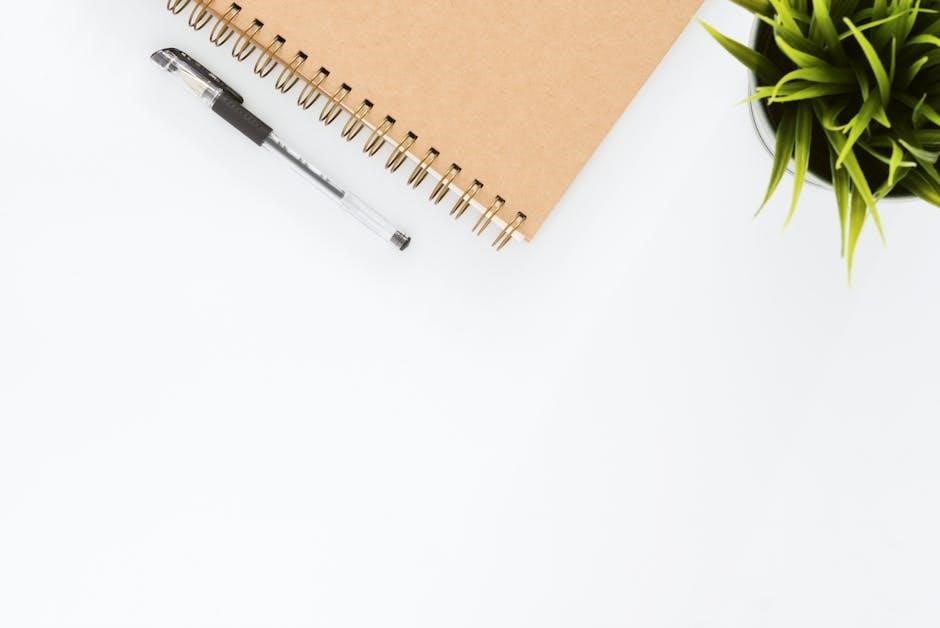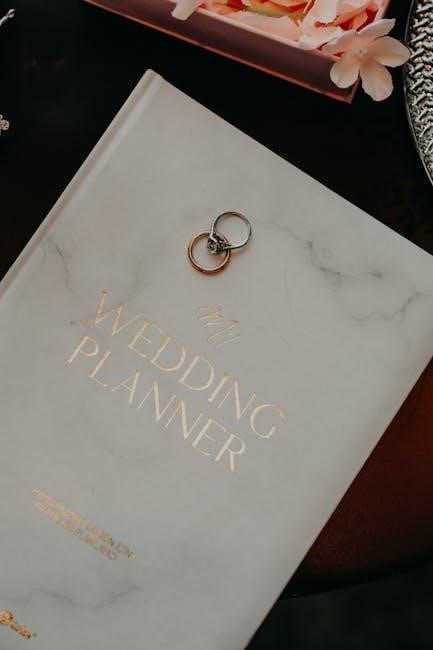Planner sizes vary to suit different needs, ensuring optimal usability and portability․ Understanding the right size enhances functionality, making it easier to organize tasks and goals effectively every day․
Why Planner Size Matters
Planner size significantly impacts functionality, comfort, and productivity․ A well-chosen size ensures the planner is both portable and spacious enough for notes, while also fitting your lifestyle․ Whether for daily tasks or creative planning, the right size enhances usability, reducing clutter and improving focus․ Choosing a size that aligns with your needs ensures your planner becomes an indispensable tool for organization and creativity, boosting overall satisfaction and efficiency in managing your time and goals effectively․
Overview of Common Planner Sizes
Planners come in various standard sizes, each catering to different preferences and needs․ From large A4 and letter-sized planners for detailed layouts to compact A6 and pocket-sized options for on-the-go use, there’s a size for everyone․ Medium sizes like A5 and B5 offer a balanced approach, while personal wide and mini planners provide specialized functionality․ Understanding these common sizes helps in selecting the perfect fit, ensuring your planner is both practical and enjoyable to use for daily organization and goal setting․

Understanding Paper Sizes
Understanding paper sizes is crucial for selecting the right planner․ Standard sizes like A4, A5, and B5 vary globally, while others like letter size are region-specific․ Common sizes are highlighted for practicality․
Standard Paper Sizes (A4, A5, B5, etc․)
Standard paper sizes like A4, A5, and B5 are widely used globally․ A4 measures 8․27 x 11․69 inches, while A5 is half its size at 5․8 x 8․3 inches․ B5, slightly larger than A5, is 6․9 x 9․8 inches․ These sizes are commonly used for planners due to their practical proportions․ A6 (4․1 x 5․8 inches) and Personal Wide (4․5 x 6․5 inches) are popular for smaller, portable options․ Understanding these standard sizes helps in selecting a planner that fits your needs and preferences perfectly․
Measurement Formats (Inches vs․ Millimeters)
Planner sizes are often measured in both inches and millimeters, catering to global preferences․ Inches are commonly used in the US, while millimeters are standard elsewhere․ For example, A5 planners measure 5․8 x 8․3 inches or 148 x 210 mm․ Dual measurements ensure compatibility and ease of understanding․ This format helps users worldwide compare sizes accurately, whether they’re familiar with imperial or metric systems․ Having both formats simplifies choosing the right planner size for individual needs and ensures a perfect fit for binders or inserts․
Common Planner Sizes Guide
Planner sizes range from large to small, catering to various lifestyles․ A4 suits work, A5 is great for everyday use, and Personal Wide offers portability․ Each size serves specific needs, ensuring the perfect fit for detailed planning or on-the-go organization․
Large Planners (A4, 8․5×11 inches)
Large planners, such as A4 (8․27 x 11․69 inches) and 8․5×11 inches, are ideal for detailed planning and organizing․ These sizes offer ample space for notes, calendars, and creative layouts, making them perfect for work, school, or home use․ A4 is a standard size in many countries, while 8․5×11 inches is common in the U․S․ Both are great for those who prefer a spacious layout for writing and designing․ These planners are popular among professionals, students, and anyone needing a comprehensive planning tool․
Medium Planners (A5, B5, 7×9 inches)
Medium planners, such as A5 (5․8 x 8․3 inches), B5 (6․9 x 9․8 inches), and 7×9 inches, strike a balance between space and portability․ A5 is a popular choice for daily planning, offering enough room for notes and schedules without being bulky․ B5 provides slightly more space, making it ideal for detailed layouts․ The 7×9-inch size is common in U․S․ planners, offering a versatile format for both personal and professional use․ These sizes are great for those who need functionality without sacrificing convenience, making them a favorite among professionals and students alike․
Small Planners (A6, Personal Wide, 4․5×6․5 inches)
Small planners like A6 (4․5 x 6․5 inches) and Personal Wide (4․5 x 6․5 inches) are perfect for portability and everyday use․ A6 planners are compact, fitting easily into handbags or pockets, while Personal Wide offers a slightly wider format for more writing space․ These sizes are ideal for individuals who prefer a lightweight, easy-to-carry option without sacrificing functionality․ They are great for jotting down quick notes, tracking appointments, or maintaining a minimalist planning style, making them a popular choice for daily use on the go․
Mini and Pocket Planners (3․5×5․5 inches)
Mini and Pocket Planners, measuring 3․5×5․5 inches (8․89 x 13․97 cm), are the smallest and most portable options․ These compact planners are perfect for carrying in wallets, pockets, or small bags, making them ideal for on-the-go use․ They are great for jotting down quick notes, tracking small tasks, or maintaining a minimalist schedule․ Their reduced size ensures they won’t weigh you down while still providing enough space for essential planning․ Popular among those who prefer simplicity and ease of use, these planners are compatible with various systems like the Mini Happy Planner and Filofax Pocket․

Planner Binding Systems
Planner binding systems vary, with popular options including ring-bound, discbound, and stapled formats․ Each offers unique benefits like flexibility, durability, and ease of page reorganization, catering to different user preferences․
Ring-Bound Planners
Ring-bound planners are a popular choice due to their flexibility and durability․ They typically feature 6 or 7 rings, allowing easy addition or removal of pages․ This system is ideal for customization, as users can personalize their planner with various inserts․ The rings are sturdy, reducing wear and tear, and the format is widely compatible with popular brands like Filofax․ Available in sizes from pocket to A4, ring-bound planners offer versatility for different planning styles and preferences, making them a favorite among both casual and dedicated planners․
Discbound Planners
Discbound planners use a innovative disc-based system for easy page addition and removal․ Unlike rings, discs allow pages to lie flat, making writing and planning more comfortable․ This format is highly customizable, with users able to add or rearrange inserts effortlessly․ Discbound systems are compatible with various planner brands and sizes, offering a sleek, modern alternative to traditional binding methods․ They are particularly popular for their flexibility and portability, making them ideal for those who frequently update or personalize their planner setup․
Planner Size Comparison Chart
This chart simplifies size differences, from A4 to pocket planners, helping you visualize dimensions and portability to choose the perfect fit for your lifestyle and needs․
Size vs․ Portability
Planner size directly impacts portability․ Larger sizes, like A4 or 8․5×11 inches, offer ample space but are less portable․ Medium sizes, such as A5 or 7×9 inches, strike a balance, fitting easily into bags․ Small and mini planners, like A6 or 3;5×5․5 inches, are ultra-portable, ideal for on-the-go use․ Consider your lifestyle: if you’re always moving, smaller sizes are more practical․ If you prefer detailed layouts, larger planners may be worth the trade-off in portability․ Choose a size that matches your daily routine and storage preferences for the best experience․
Size vs․ Functionality
Planner size significantly influences functionality․ Larger sizes, like A4, provide ample space for detailed layouts, making them ideal for complex planning or artistic designs․ Medium sizes, such as A5, balance space and portability, suiting everyday use․ Small and mini planners focus on essentials, offering streamlined layouts for quick notes․ Choosing the right size ensures your planner meets your functional needs, whether for creativity, organization, or simplicity․ Select a size that aligns with how you plan to use it, optimizing both usability and efficiency․
Choosing the Right Planner Size
Selecting the perfect planner size involves matching it to your lifestyle and needs․ Consider portability, note-taking space, and frequency of use to find the ideal fit for your planning style․
For Everyday Use
For daily planning, medium-sized planners (A5, B5, or 7×9 inches) are ideal․ They offer ample space for notes and schedules while remaining portable․ A5 planners, measuring 5․8 x 8․3 inches, are popular for their balance between usability and compactness․ B5 planners (6․9 x 9․8 inches) provide slightly more room for detailed planning․ Both sizes are compatible with ring-bound, discbound, or other binding systems, making them versatile for everyday tasks․ Choose a size that fits your bag and lifestyle for seamless organization and productivity on the go․
For Travel or Portability
Mini and pocket-sized planners are perfect for travel due to their compact design․ Measuring 3․5×5․5 inches or 89×127 mm, these planners are lightweight and easily fit into small bags or pockets․ They offer enough space for daily essentials without compromising portability․ Popular options include the Mini Happy Planner and Filofax Pocket, compatible with ring-bound or discbound systems․ These sizes are ideal for on-the-go organization, ensuring you stay productive without being weighed down․ Their portability makes them a great choice for travelers seeking convenience and efficiency․

Customizing Your Planner
Personalize your planner with printable inserts and templates tailored to your needs․ Choose backgrounds, layouts, and add text or images for a unique, functional planning experience․
Printable Inserts for Different Sizes
Printable inserts are available in various sizes to fit your planner perfectly, from A4 to A6 and Personal Wide․ Customize layouts, colors, and templates to suit your preferences․ Add text, images, or stickers for a personal touch․ Inserts are compatible with ring-bound, discbound, and other systems․ Choose from daily, weekly, or monthly spreads․ Portable options like Mini Happy Planner inserts are ideal for on-the-go use․ Downloadable guides ensure a seamless match for your planner size, helping you stay organized and creative․ Find the perfect fit to enhance your planning experience effortlessly․
DIY Planner Size Adjustments
Customize your planner with DIY size adjustments for a perfect fit․ Print inserts on various paper sizes, then trim them to match your planner’s dimensions using scissors or a craft cutter․ Measure carefully to ensure alignment․ For ring-bound systems, punch holes to fit your binder․ Discbound planners allow easy page additions․ Experiment with layouts and sizes to create a personalized setup that suits your needs․ DIY adjustments save money and let you tailor your planner for maximum functionality and aesthetic appeal․ Get creative and make your planner truly unique!

Final Tips for Planner Size Selection
Measure your planner to ensure fit, consider portability vs․ functionality, and customize inserts for your needs․ Choose a size that balances practicality with personal preference for optimal use․
How to Measure Your Planner
Measuring your planner accurately ensures the perfect fit for inserts and binders․ Use a ruler to measure the width and height in inches or millimeters, ensuring precise dimensions․ Compare these measurements to standard planner sizes like A4, A5, or B5․ Note that some planners have slightly varied dimensions, so double-check compatibility․ For discbound or ring-bound systems, measure the page size separate from the cover․ Accurate measurements help avoid sizing mismatches and ensure inserts fit seamlessly․ Always refer to a downloadable size guide for quick comparison and planning efficiency․
Downloadable Planner Size Cheat Sheet
A downloadable planner size cheat sheet simplifies finding the perfect fit․ This handy reference includes size comparisons, paper formats, and popular planner dimensions․ Quickly identify A4, A5, B5, and other sizes, along with inch and millimeter measurements․ The guide also highlights binder types like ring-bound and discbound systems․ Print or save it for easy access when shopping or customizing inserts․ This cheat sheet ensures you never second-guess planner compatibility again, making your planning journey seamless and efficient․ Download now and plan with confidence!
